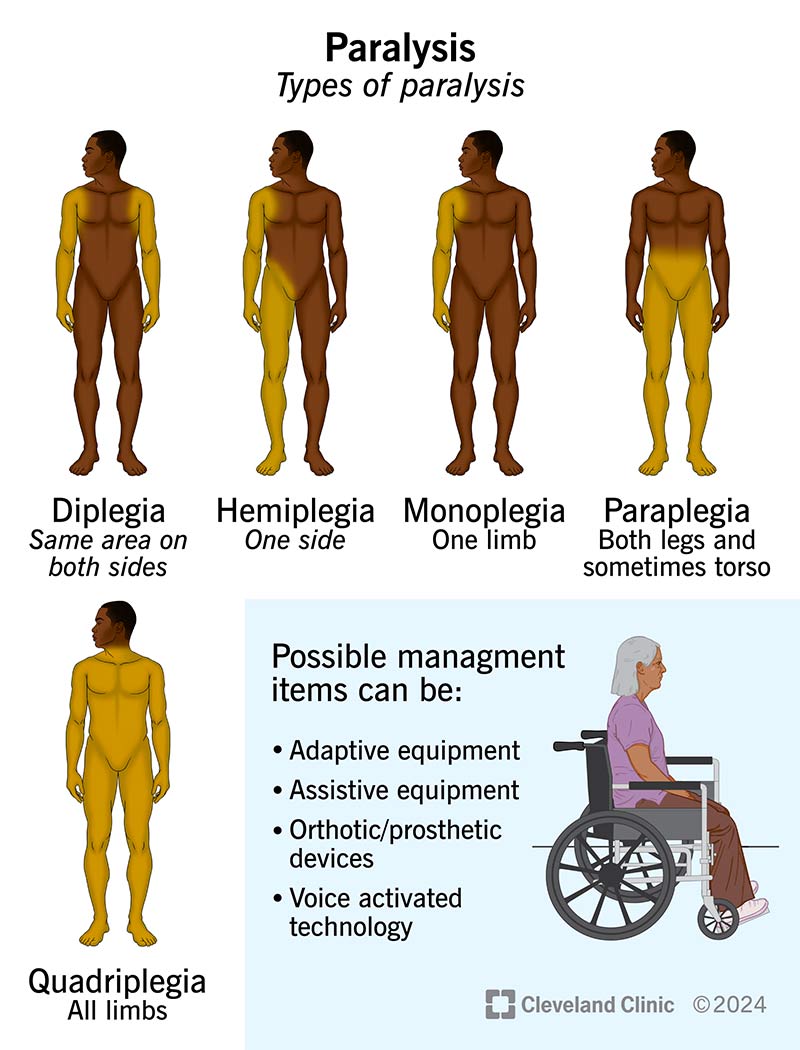When something disrupts nerve signals to your muscles, you may experience paralysis — being unable to make voluntary movements. Common causes of paralysis include strokes, spinal cord injuries and nerve disorders like multiple sclerosis. Bell’s palsy causes temporary facial paralysis. Paraplegia involves both legs, while quadriplegia affects all limbs.
Advertisement
Cleveland Clinic is a non-profit academic medical center. Advertising on our site helps support our mission. We do not endorse non-Cleveland Clinic products or services. Policy

Paralysis occurs when you’re unable to make voluntary muscle movements. A nervous system problem causes paralysis. Nerves send signals to your muscles. Those signals make your muscles move. When you’re paralyzed, or have paralysis, you can’t move certain parts of your body.
Advertisement
Cleveland Clinic is a non-profit academic medical center. Advertising on our site helps support our mission. We do not endorse non-Cleveland Clinic products or services. Policy
Paralysis can affect any part of your body. It can be:
Paralysis can also be broken down into two types based on the site of injury in your nervous system:
Approximately 1 in 50 Americans, or 5.4 million people, have some form of paralysis.
Some people experience temporary paralysis and regain partial or full movement over time. For example, Bell’s palsy typically temporarily paralyzes your facial muscles. Palsy is the name for paralysis accompanied by tremors.
Permanent paralysis means you never regain muscle control. The condition is irreversible (can’t be reversed).
Localized paralysis affects a small section of your body. It most commonly affects your face, hands, feet or vocal cords.
Generalized paralysis affects a larger area. Healthcare providers categorize generalized paralysis based on the extent of paralysis. The different types of paralysis include:
Advertisement
If you have paralysis, you’re partly or entirely unable to move the affected parts of your body. Paralysis may be accompanied by a loss of sensation depending on the location of the injury.
Paralysis can be present at birth, for example with cerebral palsy.
Strokes and spinal cord injuries cause sudden paralysis.
Some medical conditions can cause gradual paralysis. You may experience the following paralysis symptoms:
A problem with your nervous system causes paralysis. Your nervous system is your body’s command and communication system. It sends signals from your brain throughout your body, telling it what to do. If something damages your nervous system, messages can’t get through to your muscles.
Most often, a traumatic injury or medical condition damages muscle and nerve function. Strokes and spinal cord injuries are the most common causes of paralysis. Other causes include:
Paralysis can affect your breathing muscles and heart rate. The condition can also involve other body systems in the affected area. Depending on the type of paralysis, you may be at risk for:
A healthcare provider will examine you and ask about any injuries. For gradual paralysis, you’ll talk about when you began noticing the problem. To learn more, your healthcare provider may order one or more tests:
Advertisement
There isn’t a cure for permanent paralysis. Temporary paralysis like Bell’s palsy often goes away over time without treatment. In some cases, there may be some improvement, particularly during the first year.
Paralysis treatment usually includes physical, occupational and speech therapy. These can accommodate paralysis and provide exercises, and adaptive and assistive devices to help improve function. These rehabilitation services can help people with all types of paralysis live independently and enjoy a better quality of life.
Other care depends on the cause of paralysis and how it affects you. Your healthcare provider may recommend rehabilitation along with:
Learning to live with paralysis is challenging. It can cause dramatic changes to your life, activities and self-image. These changes can result in mental health issues and depression. Talk with your healthcare provider about getting physical and emotional support.
Advertisement
Over time, and with rehabilitation, many people with paralysis learn to adapt. Many people lead independent, active lives with paralysis. People with quadriplegia often need lifelong help from others, but their minds can stay active.
Maintaining a healthy lifestyle is very important to decrease the risk of complications from paralysis. Keeping an exercise routine is generally recommended, choosing exercises that are consistent with one’s abilities.
Spinal injuries are a leading cause of paralysis. You can lower your chances of spinal injury by taking these steps:
You should call 911 if you have signs of stroke or if someone has a possible head, neck or spine injury. Other reasons to get immediate medical help include:
Advertisement
You may want to ask your healthcare provider:
Paralysis is a life-changing condition. Even temporary paralysis can affect your ability to do the things you love. If paralysis occurs suddenly, it can be challenging to adjust to major changes to your way of life. Your healthcare provider can guide you as you choose among the many available rehabilitation and mental health services. Many people with paralysis enjoy active lives with mobility devices and the support of loved ones.
If you have a neurological condition, you want expert advice. At Cleveland Clinic, we’ll work to create a treatment plan that’s right for you.

Last reviewed on 10/22/2024.
Learn more about the Health Library and our editorial process.